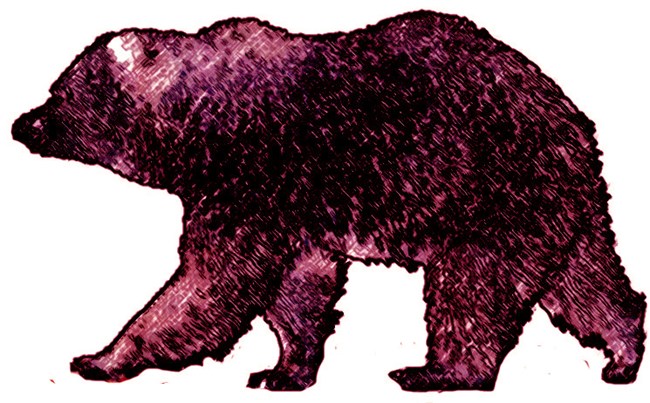
From Yellowstone Science 23(2): pages 44-45. Kingdom: Animalia Phylum: Chordata Class: Mammalia Order: Carnivora Family: Ursidae Subfamily: Ursinae Genus: Ursus (Latin word meaning "bear") Species: arctos (Greek word meaning "bear") Common Names: grizzly bear, brown bear, silvertip Names in Other Languages: Spanish: Oso café/grande, French: Ours brun Group of Bears: sleuth Life Span: 20-30 years; oldest known in GYE 31 years Pelage: from black to brown to light blonde Locomotion: tetrapedal, plantigrade Speed: 35-40 mph Claw Length: average 1.8 inches (45 mm), longest 5.9inches (150 mm);claw length and shape allow efficient digging of foods from the ground but are less efficient for tree climbing than black bear claws Tree Climbing Ability: cubs and younger, smaller bears are proficient tree climbers; however, adult male and female grizzly bears are also capable of climbing trees Tail Length: 3-4.5 inches Body Temperature: 36.5-38.5°C (98-101°F) during active season;34.4-35°C (94-95°F) during hibernation Respiration: 6-10 per minute; <1 per minute during hibernation Heart Rate: 40-50 beats per minute; 8-19 beats per minute during hibernation Eyes: blue at birth, brown as adults, and greenish yellow in headlights in the dark Vision: possibly equal to human vision; exhibits color vision and excellent night vision Genetics: 74 diploid chromosomes Number of Bones: male = 225, female = 224 (not counting the metapodial sesamoid bones and hyoid bones) Number of Teeth: 42 Dental Formulae: I 3/3, C 1/1, P 4/4, M 2/3 = 42 (upper [each side] = 3 incisors, 1 canine, 4 premolars, 2 molars; lower [each side] = 3 incisors, 1 canine, 4 premolars, 3 molars) Feeding Habits: omnivorous carnivore; opportunistic generalist Caloric Requirements: normal (May-Sept): 5,000-8,000 kcal/day; hyperphagia: 20,000 kcal/day; hibernation 4,000 kcal/day Average Body Mass: adult male = 413 lb (187 kg); adult female = 269 lb (122 kg) Heaviest Known Weight in GYE: adult male = 715 lb (324 kg); adult female = 436 lb (198 kg) Estimated Number Currently Living in the GYE: 714 Area Occupied in GYE: 58,000 km2 (22,394 mi2) Average Home Range Size in GYE: males = 874 km2;females = 281 km2 Social Behavior: generally solitary except at concentrated food sources (ungulate carcasses, trout spawning streams, moth aggregation sites, etc.), during courtship, or when accompanied by young Adult Sex Ratio: 50:50 (M/F) Age Composition: 19% cubs, 13% yearlings, 25% subadults (2-4 yrs.), 43% adults Period of Courtship: mid-May through mid-July Delayed Implantation: grizzly bears exhibit obligate delayed implantation or embryonic diapause Gestation: 235 days (implantation of embryo delayed until late November/early December) Birth Period: late January/early February Birth Location: in winter den Den Entry: pregnant females –1st week November;other females –2nd week November;males –2nd week November Average Denning Duration: females with cubs –171 days;other females –151 days;males –131 days Den Emergence: males –4th week March; other females –3rd week April;pregnant females –4th week April Typical Den Types: excavated (i.e., dug) = 91%;natural cavity = 6%;snow = 3% True Hibernators?: yes, although bears are shallow hibernators and do not drop their body temperatures as low as many hibernators, they are considered to be true hibernators Weight Loss During Hibernation: 15-30% of body weight Average Age of First Reproduction (FEMALES): 5.8 years Litter Size: range 1-4 cubs per litter; average 2.04 cubs per litter Interbirth Interval: average = 2.78 years Reproductive Rate: 0.336 female cubs/female/year Survival Rate: cubs = 55%;yearlings = 54%;subadults = 95%; adult females = 95%;adult males = 95% Causes of Mortality (GYE): human causes = 85%;natural causes = 15% Period of Maternal Care: 18 to 42 months;average = 30 months Nursing Characteristics: females have three pairs of functional nipples Bear Milk: 30% fat, 15% protein Cubs' Eyes Open: at approximately 21 days Weaning: nutritional dependence on mother's milk ends at approximately 24 weeks;offspring may continue to nurse occasionally until they separate from their mothers Bibliography Brown, G. 2009. The bear almanac: a comprehensive guide to the bears of the world. Second edition. The Lyons Press, Guilford, CT, USA. Craighead, J.J, J.S. Sumner, and J.A. Mitchell. 1995. The grizzly bears of Yellowstone: their ecology in the Yellowstone Ecosystem, 1959-1992. Island Press, Washington, D.C., USA. Haroldson, M.A., and F.T. van Manen.2015. Estimating number of females with cubs.Pages 11-20 in F.T. van Manen, M.A. Haroldson, and S.C. Soileau, editors. Yellowstone grizzly bear investigations: annual report of the Interagency Grizzly Bear Study Team, 2014.U.S. Geological Survey, Bozeman, Montana, USA. Haroldson, M.A., M.A. Ternent, K.A. Gunther, and C.C. Schwartz. 2002. Grizzly bear denning chronology and movements in the Greater Yellowstone Ecosystem. Ursus 13:29-37. Interagency Grizzly Bear Study Team. 2012. Updating and evaluating approaches to estimate population size and sustainable mortality limits for grizzly bears in the Greater Yellowstone Ecosystem. Interagency Grizzly Bear Study Team, U.S. Geological Survey, Northern Rocky Mountain Science Center, Bozeman, Montana, USA. Schwartz, C.C., M.A. Haroldson, and S. Cherry. 2006. Reproductive performance of grizzly bears in the Greater Yellowstone Ecosystem, 1983-2002. Pages 18-24 in C.C. Schartz,, M.A. Haroldson, G.C. White, R.B. Harris, S. Cherry, K.A. Keating, D. Moody, and C. Servhen, editors. Temporal, spatial, and environmental influences on the demographics of grizzly bears in the Greater Yellowstone Ecosystem. Wildlife Monographs 161. Schwartz, C.C., S.D. Miller, and M.A. Haroldson. 2003. Grizzly bear. Pages 556-586 in G.A. Feldhamer, B.C. Thompson, and J.A. Chapman, editors. Wild mammals of North America: biology, management, and conservation. Second edition. The John Hopkins University Press, Baltimore, Maryland, USA. |
Last updated: December 21, 2015
